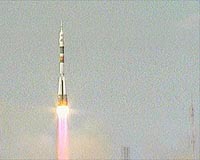 |
RIA Novosti commentator Moscow (RIA Novosti) May 29, 2009 Space mission 20, dubbed "increment", which will be known as expedition 21 after the Soyuz TMA-15 docks with the ISS, has particular historical significance for space exploration. It is the first time a Canadian astronaut has flown to the International Space Station on board a Russian space capsule, rather than in the shuttle. It is also the first time the Soyuz space craft's crew is wholly international with service backgrounds: Canadian astronaut Robert Thirsk, a medical officer, served onboard a submarine, and Belgian spaceflyer Frank De Winne was a brigadier general in the army and saw active combat in Yugoslavia. Both astronauts have already been in orbit, but it is Roman Romanenko's first time in space. Expedition 20/21 has wholly peaceful, absolutely humanitarian objectives. Frank's primary task will be carrying out experiments in psychology, biology, radiation biology, dosimetry, liquid physics, and material studies. Robert will be studying the balance and deviation in movement, which is particularly important for the elderly, those suffering from dizziness and weaknesses linked to limited mobility. Roman made it quite clear that "It won't be that one of us will be doing experiments all the time, while the others only works on keeping the station running. The planning group in the Mission Control Center will allocate work so that each person is involved in both scientific experiments and maintenance performed abroad." They will not live like shift workers, in their cabins, but as colleagues. Once again the mission involves a member of a Russian dynasty of cosmonauts: The father of the mission commander, Roman Romanenko, has been in space three times. Yury Romanenko was with Georgy Grechko when they carried out the first spacewalk in December 1977. They spent an hour and a half checking Soyuz-6 docking unit's integrity. The heads of three space agencies and the crown prince of Belgium accompanied the crew to the launch site and watched the lift-off. Now they are all waiting for it to dock, for after the crew arrives at the ISS orbiting laboratory on May 29 the space station will become fully operational with the first-ever full six-person crew. Back in Moscow, when the head of Roskosmos, Anatoly Perminov, held the traditional send off ceremony, he said: "This expedition is groundbreaking, momentous. From now on, until the International Space Station concludes its work in 2015 or 2020 it will be home for six ambassadors from Earth." True, this has happened before, on the Mir space station, but that only saw short term shuttle visits. The head of the European Space Agency Jean-Jacques Dorden said, at Baikonur: "Now half a dozen astronauts will be able to build up their experience in orbit over the course of half a year. This crew will ensure a much more effective use of on board resources in the interest of scientific and technical progress." And already the current expedition has 44 experiments scheduled, which the current crew, consisting of Russia's Gennady Padalka, American astronaut Michael Barratt, and Japan's Koichi Wakata, who will be there to greet the new team members, will also participate in. In October Padalka will hand over his commanding role to De Winne. So far Russia has not been carrying out the kind of broad ranging space research that NASA has: combining manned and unmanned missions, and improving telescopes with the help of those people in space. That is why the Rusalka (Mermaid) Russian sensing device will be working on board the ISS to detect the level of greenhouse gases. And according to the director of the Space Research Institute of the Russian Academy of Sciences, Lev Zeleny, who installed the device with the help of the ISS crew, our scientists are planning to launch a whole squadron of mini-satellites that will monitor the environment of the earth. So work will begin on the station by representatives from all those who invested in the construction and development of the ISS: Russia, the United States, Canada, Japan and the European Space Agency. The new stage continues space construction, from the defining of the joint configuration of the station involving Russian participation in 1993, the launch of the first component - the Russian-built Zarya (Dawn) control module in 1988, and the beginning of research work by the first permanent ISS expedition in 2000. On June 13 the space shuttle Endeavour will supply the ISS with the Japanese laboratory Kibo for microgravity experiments. Russia has also made commitment to launch its own multifunction lab module. The opinions expressed in this article are the author's and do not necessarily represent those of RIA Novosti.
Source: RIA Novosti Share This Article With Planet Earth
Related Links ISS Station at NASA Station and More at Roscosmos S.P. Korolev RSC Energia Watch NASA TV via Space.TV Space Station News at Space-Travel.Com
 Astronauts blast off to double space station crew
Astronauts blast off to double space station crewBaikonur, Kazakhstan (AFP) May 27, 2009 Three astronauts, from Canada, Belgium and Russia, blasted off Wednesday for the International Space Station in a landmark mission that will double its crew to six for the first time. Belgian Frank De Winne, Canadian Robert Thirsk and Russian Roman Romanenko lifted off from the Baikonur cosmodrome aboard a Russian Soyuz rocket. Well-wishers including Prince Philippe of Belgium applauded ... read more |
|
| The content herein, unless otherwise known to be public domain, are Copyright 1995-2009 - SpaceDaily. AFP and UPI Wire Stories are copyright Agence France-Presse and United Press International. ESA Portal Reports are copyright European Space Agency. All NASA sourced material is public domain. Additional copyrights may apply in whole or part to other bona fide parties. Advertising does not imply endorsement,agreement or approval of any opinions, statements or information provided by SpaceDaily on any Web page published or hosted by SpaceDaily. Privacy Statement |